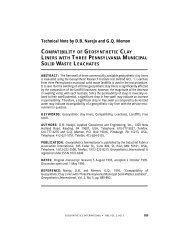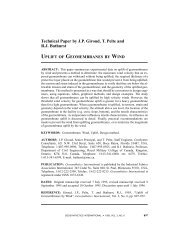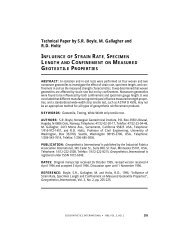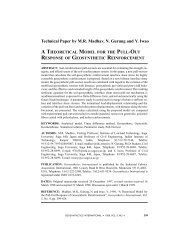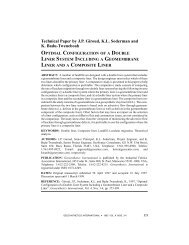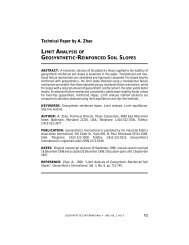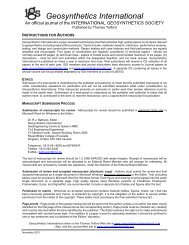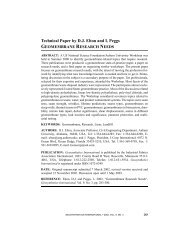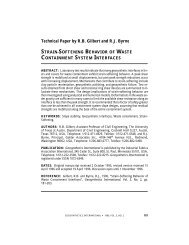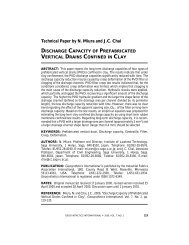leachate flow in leakage collection layers due to defects in ...
leachate flow in leakage collection layers due to defects in ...
leachate flow in leakage collection layers due to defects in ...
You also want an ePaper? Increase the reach of your titles
YUMPU automatically turns print PDFs into web optimized ePapers that Google loves.
GIROUD et al. D Leachate Flow <strong>in</strong> Leakage Collection Layers Due <strong>to</strong> Geomembrane Defects<br />
Table 2. Rate of <strong>leachate</strong> migration through a defect <strong>in</strong> a geomembrane primary l<strong>in</strong>er as a<br />
function of the defect diameter and the head of <strong>leachate</strong> on <strong>to</strong>p of the primary l<strong>in</strong>er.<br />
Leachate head on <strong>to</strong>p of the<br />
Geomembrane primary l<strong>in</strong>er defect diameter, d (mm)<br />
primary l<strong>in</strong>er, h prim (mm) 1 2 3 5 10 20 50 100<br />
5 13 51 115 319 1,275 5,101 31,881 127,523<br />
10 18 72 162 451 1,803 7,214 45,086 180,345<br />
50 40 161 363 1,008 4,033 16,131 100,816 403,264<br />
100 57 228 513 1,426 5,703 22,812 142,575 570,301<br />
300 99 395 889 2,469 9.878 39,512 246,948 987,790<br />
Note: The tabulated values of the rate of <strong>leachate</strong> migration, Q, through a geomembrane defect were<br />
calculated us<strong>in</strong>g Bernoulli’s equation (Equation 20) and are expressed <strong>in</strong> liters per day (lpd).<br />
Table 1 shows that, <strong>in</strong> the case of a <strong>leachate</strong> head on <strong>to</strong>p of the secondary l<strong>in</strong>er on the<br />
order of 100 mm, which is possible and acceptable <strong>in</strong> the case of a large leak, the rates<br />
of <strong>leachate</strong> <strong>flow</strong> that can be conveyed by the various <strong>leachate</strong> <strong>collection</strong> <strong>layers</strong> are on<br />
the follow<strong>in</strong>g order: gravel, 100,000 lpd; geonet, 10,000 lpd; and sand, 1,000 lpd.<br />
Therefore, geonets and, <strong>to</strong> a greater extent, gravel are suitable for all of the defect scenarios<br />
mentioned above, whereas sand is not. However, it should be noted that, with a<br />
maximum head on the order of 100 mm, a geonet is full <strong>in</strong> a certa<strong>in</strong> area around the<br />
primary l<strong>in</strong>er defect, whereas a gravel <strong>leakage</strong> <strong>collection</strong> layer is not.<br />
If the primary l<strong>in</strong>er is a composite l<strong>in</strong>er (e.g. a geomembrane on a geosynthetic clay<br />
l<strong>in</strong>er) the rate of <strong>leachate</strong> migration through a geomembrane defect is several orders of<br />
magnitude less than through the same defect <strong>in</strong> a geomembrane used alone. Therefore,<br />
a geonet <strong>leakage</strong> <strong>collection</strong> layer is not likely <strong>to</strong> be filled with <strong>leachate</strong> migrat<strong>in</strong>g<br />
through a composite primary l<strong>in</strong>er.<br />
4 WETTED ZONE<br />
4.1 Shape of the Wetted Zone<br />
4.1.1 Equations of the Parabola<br />
From Section 2.2, it is already known that the wetted zone has the shape of a parabola.<br />
The equation of the projection of this parabola on a horizontal plane will be provided<br />
<strong>in</strong> this section, and any subsequent reference <strong>to</strong> the wetted zone (e.g. equation, surface<br />
area) will be related <strong>to</strong> the projection on a horizontal plane. However, it should be noted<br />
that the width of the parabola is the same <strong>in</strong> the actual parabola (on the plane <strong>in</strong>cl<strong>in</strong>ed<br />
at angle β ) and its projection on a horizontal plane.<br />
Several po<strong>in</strong>ts of the parabola (Figure 6) are known from Figure 4. Thus, Figure 4a<br />
and Equation 4 show that the distance between the projection, O, of the <strong>flow</strong> apex, A,<br />
and the vertex, V, of the parabola is:<br />
228 GEOSYNTHETICS INTERNATIONAL S 1997, VOL. 4, NOS. 3-4



